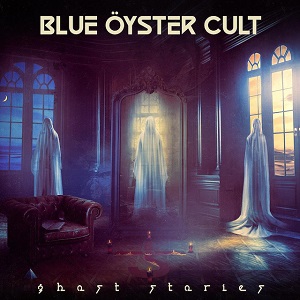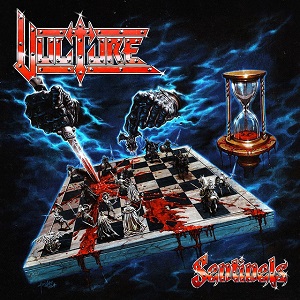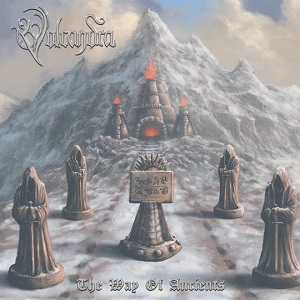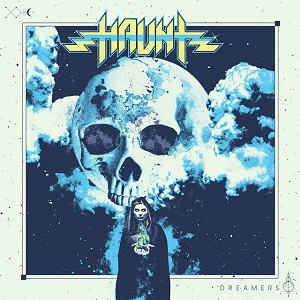Death Is Just The Beginning Part 2 - Epidemic Records
October 8, 2012, 11 years ago
If you were a Canadian metalhead in the late ’80s and early-to-mid-’90s, the following words may mean a great deal to you: MONSTER VOODOO MACHINE. MALHAVOC. SOULSTORM. OVERTHROW. Those bands, along with some lesser-knowns like EPILEPTIC BRAIN SURGEONS, BEYOND, and SING ALONG WITH TONTO, and a little Floridian prog-death band by the name of CYNIC, all had one thing in common. They were on the Epidemic Records roster.

The label, known for its iconic "E" logo, was a meeting point for some of Canada’s most unique, interesting, and forward-thinking bands at the time. Unfortunately, history has not given Epidemic the treatment it deserves.
"I’m going to be quite blunt here," says Adam Sewell, who fronted Monster Voodoo Machine. "I don’t understand how the label and the majority of the Epidemic-era bands have been almost erased from Canadian history. It’s almost as if this period of amazing Canadian music history didn't happen."The problem lays not so much in the label releasing sub-par albums, but in that it released above-average albums from bands that just didn’t fit in anywhere.
"I get that the conservative metal fans—the ones who want their metal bands to be ‘metal’ full stop—and the Can-rock/indie fans wouldn’t care about most of the Epidemic bands," says Sewell. "But when you look at everything that Epidemic did as a label, and what the bands on the roster did as far as achieving international recognition, and really helping to shape modern hard rock, metal, and experimental music, it’s absolutely infuriating. The label and the bands deserve their rightful places in Canadian music history."So let’s give it to them. But first, let’s go back: we need to start at the beginning.
Epidemic Records was founded in 1989 by Ron Sumners, who had played drums in Canada’s SLAUGHTER. He had left the band three years previously, and after experiencing so much frustration with the music industry during their time together, Sumners thought it was time to do things right.

He started jamming again with some pals and doing work as a graphic designer for other bands while brainstorming record label concepts. In ’89 he came across OVERTHROW and knew that they would be the first band on the record label that he wanted to start.
"I immediately loved Overthrow," says Sumners. "I thought they were brilliant and really wanted them to be the first band representing my new label. I had spoke to Nick (Sagias, bassist/vocalist), and told him my intentions and by May we managed to release an awesome demo cassette with full-colour foldout graphics. It sounds silly nowadays, but that quality of printing was hugely expensive back then, and with all my contacts, I was able to put together an impressive package that stood out from the other bands’ photocopied tapes and handwritten releases."
Sumners says that things started happening fast after that. The label, which ended up putting out 17 releases in all, got national distribution from Cargo and Record Peddler, which opened up more doors. But also started putting the pressure on Sumners.
"A&R; people from the big labels would tell me that ‘we’re watching your label’ and things like that… it was getting bigger and bigger very quickly," says Sumners. "As the label grew, the pressure on me for money and support also grew. I began to do too much trying to please all the bands—I would try to go to all the recording sessions, sometimes all night until I slept on the studio floor to get an hour of sleep before needing to get to my day job.""On the weekends I glued and stapled flyers all over for upcoming shows or drove to some city to sell product until the last drunk sweaty metal fan left the table clutching a new shiny Epidemic album," he continues. "Lawyer fees were getting absurd, I was getting worn down, losing weight, and the bands on my label were getting understandably more demanding for the label’s attention and funding."
The label ended up releasing strong full-lengths from the above-mentioned bands, as well as DEEP END, DOMESTIC VIOLENCE, THE MAD, and TRIGGER HAPPY. But despite a pressing and distribution deal with Metal Blade, and success in particular with Malhavoc (who released their famous trio of The Release, Premeditated Murder, and Punishments through Epidemic), Sumners’ good intentions were getting annihilated by the realities of the music business.
The final straw came on what Sumners calls a "cloudy day in March 1993," when a letter from, of all things, the Rolling Stones’ publishing company showed up. Turns out the company had caught wind of Malhavoc’s Premeditated Murder album, which featured a sample of ‘Sympathy For The Devil’ in the song ‘Dead’. The company demanded that Epidemic withdraw, destroy, and pay them for every copy of Premeditated Murder that had been pressed.
"It was a dark day at Epidemic," says Sumners. "Neither my lawyer or Warner/Chappell—Malhavoc’s publishing company—would help me with this issue; they all turned their backs on me. I paid the lawyers what they demanded, stopped production on any further versions of Premeditated Murder, and altered the masters for the Epidemic/Metal Blade/Devotion release in the States and Europe. That was the turning point for me and the label. I quickly realized that music wasn't about music—it was all about money."
Increasing tensions with the members of Malhavoc, who had around this time sent a lawyer over to claim that Epidemic hadn’t paid them royalties (which Sumners calls an "absurd untruth"; Malhavoc did not respond to a request to be in this story), added to Sumners’ general disdain. Metal Blade was releasing the Soulstorm record in the States around this time as well, but because Sumners always dealt more with verbal/handshake agreements than with written contracts, legal problems arose over this as well.
Then, Malhavoc and the label parted ways and things unravelled further.
"When Malhavoc left and took the rights with them, my relationship with my worldwide distribution ended abruptly, with my company having little recourse in collecting future royalties for either the Malhavoc or Soulstorm material," says Sumners. "I was stupid and my label died fast."What Sumners refers to as "the final bullet through the mouth" came when he paid for a full day’s worth of mixing for a TRIGGER HAPPY album he was releasing. The band was playing in Montreal and decided to stay there an extra night, says Sumners. They told him that they trust him with the mix and to just go ahead and do it by himself, he says. When the band heard the mix, they didn’t like it, and that incident right there led to the final collapse of Sumners and the label.
"I was quite angry and stormed out of the studio yelling that the label was finished," says Sumners. "Thinking about it now, it wasn’t that big of a deal, but then, with all the bad things happening within a few months of each other, I decided I couldn't take the pressure any longer.""Basically the label grew too fast for the bulk of work to be on the shoulders of one person," he continues. "I was unorganized and should have done many things differently. It might sound like I’m putting blame on individual bands, but I blame the label’s demise on myself for not doing things properly and not dealing with legal issues accordingly."
Monster Voodoo Machine released the Burn EP in 1992 on Epidemic. There was talk of releasing an album on the label, but it never happened. Things started happening really fast for the band around that time and they ended up signing to RCA for their next release.

Sewell makes it very clear that despite Monster Voodoo Machine signing to RCA, he has nothing but respect for Epidemic and what the label did for the Canadian scene.
"I loved the idea of the label, and the community around it," he says. "And I loved that Ron made things happen. No Toronto indie metal/hardcore/whatever labels had ever been so professional, and made such an impact with local bands on that scale before Epidemic. There was advertising, street marketing, videos on TV, mini record stalls at shows, all of these things that I’m sure people would take for granted now, but Epidemic was really the first to do it like that.""The label was everywhere," he continues, "and it seemed to energize everyone in that scene. They also broke the rules as far as having an incredibly progressive and diverse roster of metal, industrial, and punk rock artists. You have no idea how exciting that was at the time."

As for working with Sumners, Sewell says that he knows he drove Sumners "absolutely fucking nuts."
"I was ‘career driven’ to the point of blindness," Sewell confesses, "and we butted heads a lot… Okay, he more than likely hated my guts or wanted to strangle me most of the time. But I have nothing but the greatest of respect for him and all of the fantastic things that he accomplished with the label. He really is a heck of guy, and I hope that he knows how much I - we - appreciated all of his hard work."Nick Sagias of Overthrow and Soulstorm (pictured below) - who are about to release their third CD, Fall Of The Rebel Angels - agrees that Sumners deserves a pat on the back for everything he did for Canadian metal.

Sagias—who says that any ideas of an Overthrow reunion have been "shelved" to "preserve the memory of what once was"—says that back in the Epidemic days, everyone was younger and everyone was working together.
"We were all young, just 17 and 18 years old, and Ron had the most experience from his days in Slaughter," says Sagias. "Ron did everything for us—pretty much whatever we needed, he supplied. We were in it together; this was our first band and our first label and Ron’s first business so we all wanted it to work. We really pushed the names out there and got a lot of response in the process."??Sumners says that he has regrets about the way he ran the label—mostly that he let it die and didn’t fight more for it at the end but also to do with business issues and not giving all the bands the amount of attention he gave Malhavoc, the label’s biggest-selling band—but he feels proud when he looks back at what Epidemic accomplished."It was my love at the time," he says. "Thinking back, I wish it would have survived and continued today."
As for where he’s at today, Sumners lives in Switzerland, plays in a blues band, and still enjoys listening to metal. As for what he’d say to the metalheads of today, Sumners is at a loss.
"I really don't know," he says. "How about 'Stay in school', 'Eat your veggies', and 'Get off my lawn'?"










